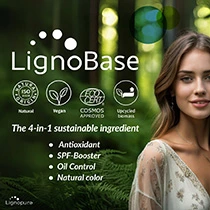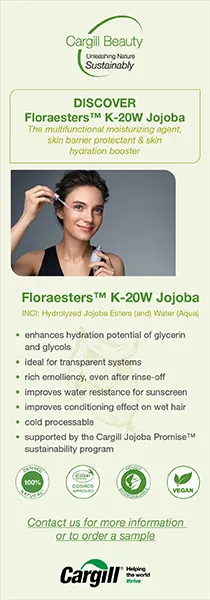Ples’Jour debuts skin-care led lubricant to shift stigma around female pleasure

Ples’Jour has launched clinically-led lubricant Opal in a bid to change the narrative surrounding female intimacy and challenge outdated perceptions of pleasure products. The brand aims to reframe intimacy as an essential part of modern self-care and “support intimacy without shame.”
The lubricant is designed to look like skin care and intentionally designed for display. The packaging draws inspiration from the premium skin care category to align with consumers’ desire for aesthetically cohesive, display-worthy beauty products.
Encased in a sculptural glass bottle with a stone-like aesthetic, the brand hopes to position Opal as more than a functional solution but an essential part of self-care.
Personal Care Insights speaks to Lauren Short, the founder of Ples’Jour, about shifting perceptions of pleasure products by promoting intimacy as a form of self-care.
“We believe pleasure is a fundamental part of wellness, not an indulgence, but a vital expression of being human. It’s not just about sex, it’s about how we connect with ourselves and how we feel in our bodies. We want to normalize the idea that taking care of your pleasure is just as important as caring for your skin, your mind, or your health.”
“When we make space for pleasure, we also make space for confidence, self-trust, and emotional well-being.”
The personal care sector conventionally frames lubricants as an intimate solution for vaginal dryness rather than a product supporting female pleasure and sexual empowerment.
Ples’ Jour discloses recent survey findings that 98% of 2,451 women agree lubricants enhance sexual pleasure, yet despite acknowledgement of their benefits, the brand reveals many consumers still hesitate to use them.
The launch reflects changing attitudes toward female sexual health and wellness, driven by the rising influence of Gen Z’s inclusive, stigma-free approach to historically taboo personal care categories.
.png) Opal is setting new standards in sexual wellness with skin-safe formula that supports the delicate vaginal microbiome.Setting standards in sexual wellness
Opal is setting new standards in sexual wellness with skin-safe formula that supports the delicate vaginal microbiome.Setting standards in sexual wellness
Traditional lubricants contain parabens, water, glycerin, sugars, and preservatives that can feed harmful microbes and alter vaginal pH. This can lead to common health concerns like bacterial vaginosis and thrush.
Opal aims to challenge ingredient standards with a safer solution to sexual enhancement. The formula claims to maintain optimal female intimate health by supporting the delicate vaginal microbiome through a safer, skin-sensitive solution.
It utilizes two high-grade silicone ingredients, dimethicone and dimethiconol, making it inert, non-porous, hypoallergenic, and water-free. It is gynaecologist-recommended, dermatologically tested, and suitable for sensitive skin.
The formula has undergone epivaginal testing using reconstructed human vaginal tissue. Results revealed that it is biocompatible with vaginal mucosa, non-irritating, and non-damaging to vaginal cells.
It has also been clinically confirmed to leave beneficial lactobacilli intact, with 100% of testers surveyed confirming that Opal made sex feel better.
What trends in the wellness space influenced Opal’s creation?
Short: There’s been a decisive shift recently, with beauty and wellness becoming more intertwined. Skin care is now considered self-care, and consumers seek a deeper connection with their products. We wanted to bring that same intentionality to sexual wellness.
Products for our most sensitive areas should be as thoughtfully formulated as the ones we put on our faces. Opal was born from the belief that pleasure is wellness and deserves the same level of care, quality, and design..png)
Opal is designed to look like skin care and intentionally designed for display.
How is the “skinification” of wellness shaping the intimate care aisle?
Short: Consumers now read ingredient labels, understand pH, and care about barrier function. That mindset extends into intimate care, where consumers are moving away from neon packaging toward products that feel elegant, trustworthy, and designed with the body in mind. This shift is helping destigmatise intimacy and normalise tools like lubricant as part of a daily wellness routine, not just for fixing problems, but for enhancing pleasure and connection.
How does Opal borrow from skin care?
Short: We initially treated Opal like a skin care product, prioritizing biocompatibility, elegant texture, and long-term safety. We chose silicone for its silky, glide-enhancing properties and because it’s non-comedogenic, non-absorbent, and widely used in dermatology for sensitive skin. Our packaging design echoes the look and feel of a high-end beauty bottle, encouraging users to see lubricant not as an afterthought but as an intimate ritual.
Who can benefit most from Opal?
Short: Opal is for anyone who wants to feel more connected, comfortable, and confident in their body. They might be experiencing hormonal shifts, postpartum changes, or dryness from stress or medication. But it’s also for people wanting to elevate their intimate experiences. There doesn’t need to be an issue or problem to use Opal, it is there to enhance every sexual experience.
What role does packaging play in shifting perception around intimate care?
Short: Packaging plays a huge role in how we perceive intimate care. When products are hidden in clinical tubes or garish branding, it sends a message that intimacy is something to be ashamed of or kept out of sight. We wanted to change that. .png) Sexual wellness brand Ples’ Jour launched clinically-led lubricant in a bid to change narrative surrounding female intimacy.
Sexual wellness brand Ples’ Jour launched clinically-led lubricant in a bid to change narrative surrounding female intimacy.
The design of the Opal bottle was inspired by natural forms like polished stones and organic shapes found in sculpture and interior design. It’s weighty, curved, and calming to hold something that feels beautiful, intentional, and worthy of display. By placing intimacy in a bottle that looks like it belongs in your home, on your shelf, we’re helping redefine it as part of your everyday wellness routine.
How is the lubricant category evolving, and what else can we expect to see from the intimate care sector next?
Short: The lubricant category is finally catching up to the broader wellness and beauty space. Consumers are looking for more transparency, elegance, and intention behind the products they use. There’s a growing shift from performance-focused or medicalized messaging to intimacy that feels personal, emotionally intelligent, and rooted in care.
We’re seeing a rise in formulations that prioritize vaginal health, are pH-friendly, microbiome-safe, and free from irritants, as well as a stronger emphasis on design that integrates seamlessly into daily life. Safety is the foundation, but pleasure is the purpose.
Looking ahead, we’ll see more crossover between skin care and intimate care, more inclusivity in product development and language, and a deeper emotional connection between brands and consumers. It’s no longer just about solving a problem, it’s about enhancing the experience of pleasure, connection, and body confidence.












